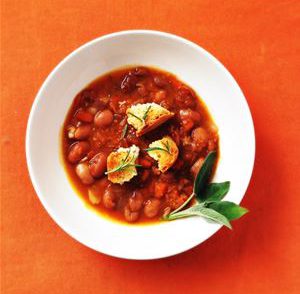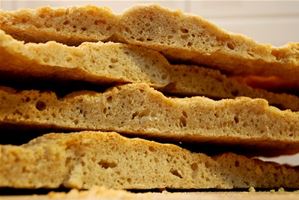The humble potato is often referred to as a tartufo bianco, a white truffle, both because of its looks and for its vital role in keeping people alive during World War II. But the potato-filled pillows of pasta that are tortelli di patate mugellani are close to divine.
A few years ago, one of my long-time truffle suppliers introduced me to the Mugello region of Tuscany, when I purchased fresh truffles from him for Procacci, the historic truffle shop on via Tornabuoni. The Mugello is by no means the most precious area in the Tuscan region for tartufi, but from time to time he found good truffles there—in his own secret locations, of course. Even though I was not allowed anywhere near his sources, I did take to the area. The Mugello is just 25 kilometres north of Florence, a lovely drive along an old road winding through the shaded countryside and small towns connecting Florence to Bologna.
I recently headed back to the area for a weekend away in a borgo (hamlet) near Barberino di Mugello, where my friend Marco’s family has a property. Between lunch and dinner, we walked to the other side of the valley, where we passed through a borgo and found a woman was harvesting the last of her potatoes before winter.
Digging potatoes from the dirt with a forked stick, wearing a simple floral dress with a worn yet clean apron covering both front and back, her face framed by wisps of her unruly hair escaping her headscarf tied tightly at the nape of her neck: the woman seemed to be from another era, or maybe we had stepped back in time. We were about 30 kilometres from the centre of Florence. This is Italy.
My companion Marco, who knows all the locals, is a fiorentino chiacchierone (a Florentine chatterbox): he talks nonstop about everything and nothing. I learn the following: Italians know that potatoes grow better above 1,000 feet; not only do they grow better but they have better flavor, too. Being from faraway New Zealand, of course, I would never have tasted such good potatoes; indeed, even though I am an international chef, I have not tasted the world’s best potatoes.
We watch as a whole string of potatoes emerges from the earth. The woman shakes off the clods of dirt, wraps the potatoes in an old piece of clean cloth whipped from an apron pocket, and hands me the package to take home. I feel guilty: I have nothing to give her in return. But no exchange of gifts is expected: ‘non é niente, é un piacere,’ said my new friend—‘It is a pleasure for me to give you my potatoes,’ she has told me.
I promised to make her potatoes into a dish worthy of her proud labours, and for this she rewarded me with a sunny, near toothless grin and a friendly wave of her earth-stained hand to send us on our way as she turned to continue her work.
I decided to prepare something based on a traditional, local recipe in this place known for its abundance of amazing ingredients. The Mugello is famous for its tortelli di patate mugellani, soft pillows of pasta with a potato filling. So, with a bundle of freshly dug potatoes and a cool evening ahead, I resolved to make this dish, the recipe I share with you here, which is one of my favourite pastas for this time of the year. Some people add raw garlic and parsley, others a little tomato for colour. But with my increasing obsession for all things pig, I am going to add some of my pancetta to the potato filling, and toss the soft potato-pancetta pillows in melted butter.
Buon appetito!
RECIPE
Tortelli di patate mugellani (serves 4)
Ingredients
Filling:
550g potatoes
2 cloves of garlic
2 sprigs of rosemary
80g pancetta, diced
20ml extra-virgin olive oil
salt and pepper to taste
2 whole eggs
50–100g freshly grated Parmesan cheese
Pasta:
400g hard durum wheat flour, plus extra for kneading and rolling out
6 egg yolks
10g salt
To serve:
100g butter
100g freshly grated Parmesan cheese
Preparation
Filling: Wash and scrub the potatoes leaving the skins on; place in a pot of cold water and bring to the boil. Simmer until very soft; to test, stick a knife into the centre of the largest potato and attempt to pick it up out of the pot. When the potato easily slides back into the pot, it is ready. Drain off all the water and place the potatoes back in the pot with the flame turned off. This will allow the potatoes to dry out. When they have cooled enough to touch, pick up the potatoes and peel, discarding the skins. Pass the potatoes through a Mouli grater or push them through a coarse sieve.
Meanwhile, in a heavy-based pan, sauté the pancetta in the extra-virgin olive oil, then add the garlic and finely chopped rosemary. Remove from the flame and add to the potatoes along with the two eggs, salt and pepper. Mix gently with a fork to keep the potatoes light. At this stage, the mixture will be a little wet, so add enough grated Parmesan to dry out the mixture and add flavour. Taste for seasoning—I often add more pepper.
Pasta: Sift the flour with the salt, place on a marble slab in the form of a mountain, make a crater in the centre and put the egg yolks in. Using your fingertips, incorporate the flour into the yolks a little at a time until a dough is formed. If the mixture is dry and crumbly, add a few sprinkles of cold water. Knead for 5–10 minutes on a hard surface until the dough is shiny and elastic. Wrap in plastic and let rest in the fridge for half an hour.
Roll out the pasta as thinly as possible with a rolling pin or a wine bottle, using a small amount of extra flour to prevent it from sticking. Leave to rest for one minute before cutting into rough rectangles about 10cm by 5cm. Place a teaspoon of the filling onto one half of each piece of pasta, wet one side only and fold over to make sealed pillows, push the three sides together to stick well. Continue until all the pasta and the filling have been used. You should end up with 24–30 pillows.
Fill a large, wide pot with water, salt it well and bring to the boil. Add the tortelli and cook until they rise to the surface, about two minutes. Remove with a slotted spoon and toss in melted butter. Serve with extra grated Parmesan.







